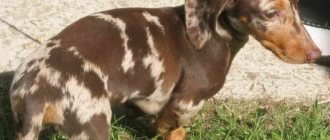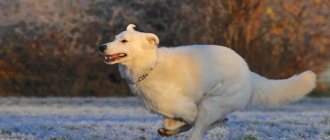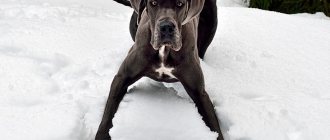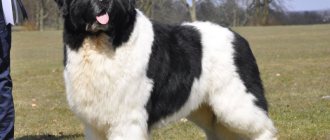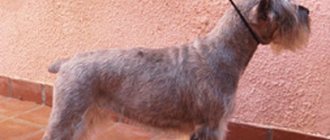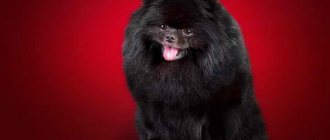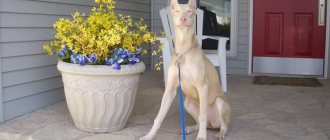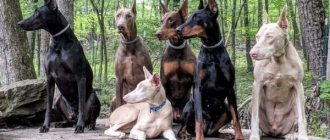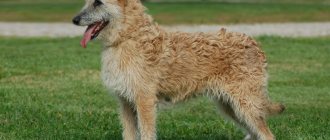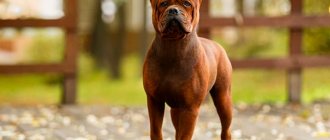Even as a puppy, the Great Dane can accidentally knock over small furniture and children. Originally bred to hunt wild boar, this dog is now a loving and gentle dog that gets along with everyone.
He takes part in various activities including tracking and guarding.
| Great Dane: description, size, weight of the breed. | |
| Breed name | Great Dane |
| Other names | German Dogg, German Mastiff |
| Nicknames | Dane, Gentle Giant |
| Origin | Germany |
| Size | Large breed of dogs |
| Average weight | From 50 to 90 kilograms |
| Average height | From 70 to 90 centimeters |
| Life period | From 6 to 9 years |
| Coat type | Short, dense, thick |
| Color | Brindle, fawn, black, blue, Harlequin and merle |
| Popularity | Very popular - ranked 15th by AKC |
| Intelligence | Average |
| Attitude to heat | Good - Can handle moderate heat |
| Attitude to cold | Moderate |
| Salivation | Quite high |
| Obesity | Not prone to obesity |
| Barking | Occasionally but loud and deep |
| Exercise needs | Slightly active - despite his size, he does not need much physical activity |
| Learning ability | Easy to learn - obeys commands well |
| Friendliness | Excellent – very sociable and friendly dog |
| Good first dog | Needs an experienced owner |
| Good family pet | This is a great and affectionate family dog |
| Good with children | Gentle and loving, but small children should be supervised as they can be knocked over accidentally |
| Gets along well with other dogs | Excellent – with socialization |
| Gets along well with strangers | Excellent – very affordable |
| Health problems | Prone to problems such as bloating, hip dysplasia, cancer and heart problems |
| Bite Statistics | Attacks: 39 Injuries: 21 Children Victims: 14 Deaths: 3 |
History of the origin of the species
The breed originated in Germany, but Great Danes have a long history. They originated from Egypt, Rome or Greece, since the Greek coins date 36 BC. e. depicts a dog similar to a Great Dane. Images of dogs similar to them were discovered on Egyptian monuments dating back to 3000 BC. e. In Tibetan literature for 1121 BC. e. Danish-type dogs are also described.
Medieval greyhounds or mastiff-type dogs were used by the Asians known as Alans who invaded Germany, Italy, Spain in 407 AD. e. They brought dogs with them, which showed great strength in killing bears and wild boars. Therefore, the Germans began to selectively breed Great Danes. The breeds chosen to breed the Dane could include the Irish Wolfhound, Mastiff, Greyhound.
In Germany, the Great Dane became the country's national dog in 1870. In 1880, it was decided that the breed, bred by the Germans, was separate and would therefore be known as the German dog. In the mid-1800s, dog lovers in the United States began importing Great Danes from Germany, and by 1891 the American Club was formed.
Varieties
German Spitz (small): description of the breed, character
The Great Dane dog breed has several varieties, most of them became the ancestors of modern canines.
Great Dane
It has an impressive volume (from 75-80 cm in height) and a body weight from 50 to 100 kg. The Great Dane can be:
- black;
- chocolate;
- golden-pearl.
Uneven spots of any shade on the body are allowed.
Great Dane
Great Dane
The second name mastiff is more often used; it is considered one of the largest dogs in the world, taking into account the ratio of volume and body weight. At the withers is higher than 78 cm, weighs more than 75 kg. There are no upper limits. Mastiffs are large, their heads are angular, and their bodies are elongated. Unlike standard Great Danes, they have thick folds of leather on their bodies.
Note! This variety of Great Dane has long ears and a wrinkled muzzle. The short coat is colored in beige, wheaten, yellow, fawn, apricot, brindle and tan tones. A black mask must be present.
Ulm Great Dane
It is a mixture of Danish and other Great Danes. The name of the line comes from the place where they appeared - the city of Ulm, located on the Danube. One of the first breed exhibitions, held in 1863 in Hamburg, presented the Ulm and Great Danes as two independent subspecies.
For your information! Hunting dog, boar dog, great dane (dog) are the old names of the classic German breed. They are considered an intermediate link between the English Mastiff and the Greyhound. The Dogo Argentino is considered a dangerous breed along with the Gul-Dong (Pakistani bulldog).
Features of Great Danes
This is definitely a pet for whom counter-surfing is a favorite pastime. A strong tail would make a good weed killer and is at just the right height to clear a coffee table. Regarding the relationship between height and length, the Great Dane should be “square” and the body should be as long as its height.
The ears are floppy and triangular, although in the US they are often trimmed. Ear cropping was done to prevent injury when hunting wild boar. There is no real reason to crop a companion dog's ears, and the practice has been stopped in many European countries.
Although Great Danes are huge, they are loving, kind, gentle, even with children. They become attached to their owner and want nothing more than to curl up in their owner's lap, although such a prospect almost always seems impossible.
Purpose
It is assumed that in ancient times Great Danes were used as personal bodyguards, who were extremely vigilant and capable of attacking at any time in order to protect the owner. Later, they began to take part in hunting large and small game: they could easily knock down a wild boar and find a bear’s hole, as they were endowed with good agility, speed and an excellent sense of smell.
In modern times, the special skills of this breed are still highly valued; they are used in many areas: in search and investigative activities, protecting the territory, and as a bodyguard. The combination of its impressive size, developed intelligence and sensitive sense of smell makes this dog universal for use by humans.
Character
Dog is a reliable friend. She is friendly, courageous, energetic. This is an easy-going breed, regardless of its size. The Great Dane is friendly, affectionate, especially with his family, and shows self-confidence in the company of strangers. He is gentle and loves nothing more than playing with children.
Their gigantic size makes them dangerous in the home environment. Children and teenagers will find these giants a dream stuffed animal.
The calm and balanced nature makes the Great Dane an ideal breed for keeping in small spaces, perhaps even in apartments. He won't mind lazing around all day with his beloved owner nearby.
Health
Great Danes are healthy dogs because they were specially bred for work, hunting bears and wild boars. The change in breeding goal caused health problems. They are vulnerable to stomach torsion, which can begin with bloating. This condition is common in large, deep-chested breeds. The reason is eating large amounts of food and drinking too much. This can lead to stomach twisting. The condition requires emergency medical attention, as the blood supply to the stomach and small intestine may be disrupted. This interferes with the normal flow of blood back to the heart and can lower blood pressure and lead to hypovolemic shock.
Apart from stomach torsion, Great Danes are prone to hip dysplasia. This condition causes pain when moving or causes lameness. If not corrected immediately, canine arthritis may develop.
Great Danes are also susceptible to:
- osteosarcoma;
- dilated cardiomyopathy;
- tricuspid valve dysplasia;
- mitral valve defects;
- subaortic stenosis.
There are other diseases that can negatively affect the health of a Great Dane. This emphasizes the fact that puppies should only be taken from reliable breeders who guarantee the absence of genetic abnormalities.
Recommended health tests: hip assessment, cardiac examination, ophthalmological examination, thyroid diagnosis.
Historical reference
Where does the history of the origin of the breed begin? This issue is controversial from time to time, causing serious unrest in the canine world. The thing is that experts cannot come to a common opinion about the first ancestors of mastiff dogs. Great Danes are descendants of Molossians - there is no doubt about that, but scientists argue about the place of origin of Molossians.
There are two main versions:
- All Molossians are descendants of the ancient Tibetan Great Danes, huge, strong, rather determined and aggressive dogs. The population of these giants originated in eastern Europe, more precisely, on the Tibetan peaks. Evidence of the existence of Tibetan Danes has been found everywhere... from Syria to Persia and Nepal. Naturally, most often, the face of giants appeared during excavations in the Middle East. The oldest evidence of Tibetan Great Danes dates back to the 7th century BC, which suggests that Molossians are the ancestors of all canines.
- Great Danes are descendants of ancient Germanic dogs. This version, oddly enough, comes from German scientists. We are talking about the 5th century BC, more precisely, the period of the birth of the ancient Germanic tribes. However, if we take the hypothesis apart, the conclusion suggests itself that German dog handlers want to see “their truth” and finally appropriate the Great Danes to their country.
It is easy to guess that the first version is more fundamental and justified, and therefore is accepted all over the world. Cave paintings are obvious evidence of the similarity of dogs, but in science, verbal descriptions or discovered remains are more valuable. Descriptions of Molossians can be found in the chronicles of the ancient Persians, who valued the life of giant dogs more than human ones. In India, Molossians performed both service and religious roles. Anubis, the God who escorted people to the other world, is described as a man with the head of a jackal, but a number of scientists are inclined to believe that the deity personified a merciless Molossian.
This is interesting! Great Danes were named Molossians after their spread to Epirus. Giant quadrupeds were actively bred and used for hunting by Molossian tribes. In fact, thanks to dogs, tribes were known throughout eastern Europe.
In ancient China, quadrupeds also played an important role. Small dogs were the property of the nobility, but Great Danes were used for specific purposes. The point is that huge rice plantations were considered sacred lands, and hunting was prohibited on them. There was a nuance - hunting was prohibited for humans; the law was silent about hunting with the help of dogs.
Great Danes changed their “professional activities” with the development of the world, this is quite predictable. Despite their hunting and guarding qualities, the Molossians left their most significant mark in the history of wars. It has been scientifically confirmed that dogs, clad in armor, marched against Egypt in the same ranks as the Persian infantry. Molossians also played the role of soldiers in the Greco-Persian War; four-legged animals also fought on the side of Persia. As you know, the self-confident Persians lost the long-term confrontation and Greece entered the dawn period.
From developing Greece, the Molossians came to Rome. The stormy dawn of the breed began in the empire. The warlike Romans highly valued the power and aggression of dogs. Quadrupeds were used in military campaigns, and in peacetime, tailed animals entertained the public by fighting in arenas. Bloody entertainment gave the "gladiators" an enviable reputation, as cruel as it may sound, this brutal period gave the Great Danes a ticket to the future.
This is interesting! Alexander the Great played a significant role in the widespread spread of the ancient Danes. The king and commander not only revered four-legged fighters, but also led a competent “marketing strategy.” Only male dogs were transferred into the wrong hands and only for a lot of money. Over time, this technique led to increased demand and popularity of the breed line.
One of the last significant military events in the history of the Great Danes was the battle between the Celts and the Romans. Despite the fact that the empire used its Molossians, the Celtic Danes provided a worthy meeting for the troops. The battlefield was flooded with rivers of blood, as the Celtic dogs turned out to be worthy warriors, and outnumbered the enemy.
With the development of the world community, the invention of weapons and technology, dogs ceased to be used in battles and Molossians moved into the hunting class. Naturally, not everyone was able to feed a giant, so if a tailed ward was acquired, then the maximum was squeezed out of his skills. Wherever Great Danes were used, dogs hunted large animals, transported carts with cargo, protected protected areas and farms, participated in demonstrative baiting, guarded slaves, and even served as a means of execution.
Care
Great Danes have relatively short fur—surprisingly smooth for their size. There are 6 colors: fawn, brindle, black, harlequin, blue, mantle. Wool does not require long-term care. A stiff bristle brush helps maintain its integrity. Regular brushing minimizes the frequency of bathing.
Frequent tooth brushing is necessary. Experts recommend carrying out the procedure at least 3 times a week, since dogs of this breed are especially susceptible to the development of tartar and plaque. Brushing your teeth daily should help prevent gum disease and also eliminate bad breath.
You need to trim your nails 1 or even 2 times a month. The dog itself will give a signal - a clicking sound that can be heard when walking on the floor. This is a sign that it's time to cut your nails.
Dossier
Adult height : males 81-90 cm, females 70-85 cm. Weight: 35-50 kg. Characteristic colors: brindle, marbled, fawn, black, blue. Coat length: short, smooth, dense; there is no undercoat. Lifespan: 6-10 years. Advantages: reliable bodyguard, affectionate friend. Difficulties: does not live long, requires a lot of attention. Average price of a Great Dane puppy: $600-800. Classification: large dogs, guard dogs, companion, bodyguard.
Content
Great Danes need daily walks to stay healthy. It is important not to overwork this breed, especially when young. Puppies grow large, which puts them at risk for joint and bone problems. Because of the puppy's natural energy, owners should take steps to minimize activity while the pet is growing.
Great Danes continue to grow (mostly by gaining weight) longer than most dogs, only reaching maturity at three years of age. Although they love to run, they are not suitable as a jogging partner until they are one year old.
Adult dogs will enjoy a long daily walk or active play in the yard. Young representatives of the breed have a lot of energy, but as they age they become quiet at home and can even live in an apartment. Even well-trained obedience dogs run without listening to commands and often get hit by a car.
This breed is easy to care for. Trim your nails monthly. Bathing is hard work, so a groomer (a modern brush) can help reduce the number of procedures. The coat should be brushed with a hard bristle brush and then treated with dry shampoo. Daily care is a good idea if you need to avoid washing.
Due to the large size of the Great Dane, it thrives best in spacious homes with room to run and play. This breed is prone to staying indoors, so spending time outside every day is important for their health.
Upbringing
The Great Dane's desire to please its owner makes it easy to train, train and obedience. Socialization should begin at an early age. You need to start acquiring basic skills as early as possible. Great Danes are not as intelligent as other dog breeds, but their desire to earn their owner's affection underscores their willingness to learn.
Inviting guests into the home can introduce Great Danes to the nature of human interactions. Visiting busy parks also helps introduce them to everyday life.
Pros and cons of the breed
Great Danes have certain characteristics:
- friendliness with family members, especially children, as well as other animals;
- self-confidence in the presence of strangers (does not show anxiety);
- no difficulties in care;
- easy training;
- devotion to one's family;
- restraint and genuine tenderness.
The Great Dane is not suitable if you:
- live in a small apartment;
- do not realize the importance of early training and socialization of puppies;
- you cannot spend a lot of time, especially for physical exercise or games;
- going to leave it for long hours every day;
- Can't stand pets that drool a lot.
How to choose a puppy
Ask to see your parents. The purebred Great Dane has a smooth, muscular body and its movements are balanced. There is no visible deformation on the bodies of the parent dogs.
Review the health examination results of the parent dogs if the breeder shows them to you. Pay attention to problems: bloating, thyroid disorders, bone problems. Puppies are required to be vaccinated before 6 weeks of age, and it is best if they have been vaccinated by a veterinarian.
Observe the behavior. Puppies interact normally with each other. Healthy offspring are alert and playful. Great Dane puppies that have undergone proper socialization show curiosity and do not shy away from human contact.
Ear cropping: mandatory or not?
It is not necessary to crop your puppy's ears. When deciding whether to prescribe this procedure, first examine the ears of his parents and evaluate the features:
- high or low setting of the ears on the skull;
- cartilage - hard or soft;
- whether the ears are cropped or not;
- are they standing, if they are trimmed;
- if not, then do they fit properly to the cheeks?
The parents' ears are studied if the baby's ears are still difficult to examine and identify their features, i.e. at approximately 1-2 months of age. In a puppy that has grown up to 2-4 months, the ears are assessed according to the same criteria as in adult animals.
Ears need to be cropped if the following indicators are detected:
- The ears of both parents are set high, stand firmly and are cropped;
- high set of ears on the puppy’s skull;
- no creases;
- light hard cartilage;
- the ears seem to be slightly raised on cartilage.
Ears should not be cropped if the following indicators are present:
- the ears of one or both parents are low-set, cropped, but do not hold an erect shape;
- or their ears are not cropped and fit properly to their cheeks;
- low setting of the ears on the baby’s skull;
- heavy soft cartilage;
- traces of creases on the ears that cannot be removed during docking.
Each pair of ears must be studied individually, even if the pets are littermates. When assessing the ears, regardless of whether you cut them or not, remember that under no circumstances should you pet a Great Dane puppy on the head, otherwise the resulting creases can ruin both cut and uncut ears.
The decision to carry out a delicate procedure is ultimately made by the dog owner himself, but before that he should consult with a dog handler or a professional breeder.
Popular types of Great Dane dogs
Many varieties have been developed. Each species has certain appearance and character traits. Before adopting a puppy, study the characteristics of the species so as not to encounter difficulties when choosing.
American
The most fearless variety of the breed, known since the end of the 19th century. Height is up to 68 cm at the withers, and body weight is about 55 kg. Sexual dimorphism is pronounced. They have long, hanging V-shaped ears and a muscular and strong build. Their coat comes in different shades such as white and grey, black, dark brown, brown.
The massive physique is deceptive - in fact, these are cute, affectionate pets. But they do require early training and socialization by an experienced owner. This is not a lap dog, but a symbol of the US Marine Corps. There are classic varieties (with a short muzzle) and standard (elongated muzzle, light build).
Argentinian
Displayed for search and service purposes. He has a complex character and is prone to aggression. He is stubborn. Needs early socialization. An elegant, muscular mastiff breed. They have a wide, deep chest, giving the overall appearance of power and confidence. They have loose skin on the neck.
Characterized by temperament and perseverance. Always wins thanks to his extraordinary strength. They are sociable and cheerful in families - they become a real support.
English
“Royal” breed, characterized by arrogant behavior. A measured dog that knows how to control its own behavior. The fur has a beige tint, there is a black mask on the muzzle, and the ears also have a dark tint.
There are folds on the face of the English Great Dane, giving it a thoughtful appearance. The dog looks like the picture.
Canary
A mix of Great Dane with Bulldog and Mahorro. Their coat color comes in different shades such as brown and white, black and white and grey. The breed was bred to work with cattle. Height does not exceed 66 cm.
This is the type of dog that will happily go fishing, hiking, or boating with you. But they usually have breathing problems, just like a purebred American Bulldog, so you shouldn't overdo it. Thus, great caution is required when going out in the sun with your dog.
Brazilian
The Filo Brasiliero breed was developed by crossing a bulldog and a mastiff. It is massive. According to the standards, all colors are allowed. The Brazilian dog has a body type that gives the impression of agility and strength. Their bodies are muscular, long and defined, and their bones are strong. They have a strong, arched neck of medium length, and muscular shoulders.
The behavior shows the traits of a hunter and a tracker. They have the character traits of the “British” - equanimity, patience and measuredness. In some countries the breed is not allowed for breeding.
German
He has an aristocratic appearance and a calm disposition. The breed was bred for hunting. It is a very calm companion accompanying a person’s life. The body is shaped closer to a square. The physique is muscular, emphasized by smooth hair.
Tibetan
Most often called a mastiff. It has a thick coat and dense undercoat. Thanks to this, it tolerates low temperatures quite well. Adult cables have a body weight of 60-70 kg. Height – at least 70 cm.
The appearance is mesmerizing. Character - brave. The dog is ready to fight with the offender. Strict training is recommended, as the Tibetan Dogo is prone to making independent decisions.
Cuban
An extinct species bred on Liberty Island (the unofficial name of Cuba). It was bred by crossing a bulldog and a mastiff. The breed was intended to search for Indians escaping slavery. There are practically no representatives left.
Alanian
SONY DSC
The breed is not recognized internationally. They were bred for hunting in pens and for baiting wild animals. The Alanian Great Dane began to disappear due to the reduction of land. It also has a special brindle coloration.
Moscow
An almost extinct breed from the Krasnaya Zvezda kennel. A Great Dane was crossed with a Shepherd. Differs in endurance and power. The forehead is sloping, the head is wedge-shaped. Characterized by special attentiveness and obedience.
French/Bordeaux
A characteristic feature of the breed is its massiveness. The skin is thick and forms folds. Has short silky fur. The standard color is red, there is no mask on the face. Has a menacing appearance.
Russian
The breed was developed using terriers, shepherds, molossians, schnauzers and mountain dogs. The breeders were faced with the task of obtaining a working dog that would perform security and watchdog functions with moderate aggression. With good upbringing, it gets along with its owners in cramped conditions.
Dwarf
A cross between a bulldog and a bull terrier, bred in America. The size of the dog is small: at the withers – 15 cm. Weight – no more than 10 kg. Thanks to its miniature size, the dog can be kept indoors. The genetics of the Miniature Great Dane make him active, curious and cheerful. Easy to train. Suitable for living in city apartments.
Neapolitan
An Italian representative of the Great Dane, the body is covered with numerous folds of skin. These are the protectors of dogs in gladiator fights. They have an elongated body and a squat appearance. Coat color is dark silver. The appearance is frightening, but the character is good-natured. In case of danger, it emits a warning bark.
Chinese
A rare medium-sized variety - a rarity for European countries. The name of the breed is Chongqing. Characterized by restless behavior, aggressiveness and courage. The fur is bright brown. Puppies need early socialization and strict housing conditions. During the training process, the puppy chooses one owner and obeys only him.
Belgian
An endangered breed bred for draft power. It was used to transport wounded soldiers, help with housework and protect the territory. The coat color is black or red. Requires physical exertion and constant activity.
Japanese
A representative of a giant breed with the characteristic appearance of a mastiff. Body weight is 40-90 kg. Adult representatives attack only on command and are distinguished by fearlessness. Characterized by power. Education requires a special and attentive attitude. It is recommended to involve professionals.
Pakistani
The breed was developed based on the Dogo Argentino. Has a strong natural grip and is courageous in all situations. Color – white with dark splashes. The pet's body weight reaches 100 kg. The breed is dangerous - there are no barriers for it. The Pakistani Great Dane can attack without warning, so it needs a strict owner and proper training.
Staffordshire
A fighting breed obtained by crossing terriers and bulldogs. It has a tough and complex character. There are notes of aggression. Difficult to educate. With a medium body size, it has excellent muscularity. Fearlessness causes the dog to fall down without warning. Has a stranglehold and does not tolerate competition. It's difficult to get along with children. Does not tolerate other pets.
Bernese
The predecessor is the Tibetan Great Dane with thick long hair. Color – tricolor (brown, black and white). The Bernese Dog is the most good-natured representative who faithfully serves, protects and cares. Loves pets and children. They are distinguished by their muscularity. Doesn't show aggression. Has a square head and muzzle.
Thai Dane
The breed was bred in Thailand. A Great Dane was crossed with a jackal, resulting in an interesting breed that deserves the attention of dog lovers. The Spitz-like species is easy to jump and train. It is distinguished by its protective character and playfulness.
When raising, you need to focus on security capabilities, carelessness and irrepressibility. You can keep it in urban apartments, despite the pet’s excessive physical activity. If you engage in active games during walks, the dog will not bother you at home.
Description
The majestic appearance and powerful, yet proportionate and elegant physique of the Great Dane express pride, strength and beauty. This is a true Apollo among many dog breeds. He evokes particular admiration for his impressive head. Even in the state of the most intense excitement, the Great Dane should not show any nervousness, but gives the viewer the impression of a chiseled statue. Nervous and cowardly Great Danes therefore, despite all their qualities, can only be assessed at an exhibition as “vicious” dogs.
- Head . Long, massive, with strict straight lines, expressive, dry (especially under the eyes), with a clearly defined transition from the forehead to the muzzle. When viewed from the side, the forehead should be clearly raised and parallel to the line of the bridge of the nose. When viewed from the front, the skull should not be wide, and the bridge of the nose should be as wide as possible; the muscles on the cheekbones should only be slightly defined and should in no case protrude. The muzzle is voluminous and should have a drooping upper lip with a blunt, vertical edge in front and clearly defined jowls.
- The length of the muzzle should be equal to the length of the forehead. The occipital protuberance is poorly defined. When viewed from all sides, the head should have strict, straight lines and be in harmony with the size and proportions of the dog's build.
- Eyes. Medium size, with dry eyelids, rounded, perhaps darker, with a lively, intelligent expression.
- Ears. Set high and not too far apart, fairly long, pointedly docked, equally tense, vertically alert, always in proportion to the shape of the head. If both ears do not have the specified shape, the show score should be reduced accordingly. Great Danes with floppy or too short-cropped ears cannot receive the “Excellent” rating.
- Nose . Large, in brindle and one-colored mastiffs it is always black; in marbled (harlequin) dogs the nose can be black-spotted or light. Dogs with a split nose are not assessed.
- Teeth. Large, well developed, tight fitting. The bite is considered correct when the upper incisors fit snugly over the lower incisors (scissor bite).
- All deviations from a scissor bite are vicious. When assessing the position of the upper jaw in relation to the lower jaw and vice versa, it is fundamentally based on the movable lower jaw.
- Neck. Set on high, long, dry, muscular, without folds or dewlap. Narrower at the head and gradually widening towards the chest. The scruff is well defined.
- Shoulders. The shoulder blades should be long and obliquely set, forming a right angle at the shoulder joints with the humerus, which promotes a wide and easy step.
- Breast. Oval in shape, deep and relatively wide, reaching down to the elbows.
- Torso . The withers represent the highest point of a dog's growth. The back is straight and short. The loin is strong, slightly convex. The lines of the back and loin are slightly inclined towards the croup.
- The height at the withers and the length of the dog are almost equal. In bitches, some stretching is allowed. The croup is wide, muscular and slightly sloping, gradually sloping towards the root of the tail. The belly and groin are well tucked in and form a beautifully curved line from the deep chest.
- Tail. The length reaches the hock joints, set high, dry, thick at the base and gradually thinning. In a calm state, the tail should be carried downwards; when excited or running, it should be slightly curved (saber-shaped) and slightly raised above the line of the back.
- Forelegs. The shoulders should be strong and muscular, the elbows should not turn out to the sides or turn inward, but should be directed strictly back in the same plane as the glenohumeral joints. Strong forearms when viewed from the front and side to the wrist are absolutely straight. The pasterns, when viewed from the front, are in line with the forearm to the very paws, and when viewed from the side, they are only slightly inclined forward.
- Hind limbs. The thighs are wide and muscular, the lower legs are long and strong. Correct placement of the hind legs is ensured when the angles in the hip, knee and hock joints are not too obtuse. When viewed from behind, the metatarsals should be absolutely straight, parallel, not close together at the hocks and not forming a barrel-shaped set.
- Paws. Round with short, arched, tightly clenched toes. The claws are short, dense, preferably dark.
- Movements . Large, light, springy step.
- Coat. The coat is very short, thick and glossy, close-lying.
Possible colors
- Tiger dogs. The main background is from light, golden-red to dark golden-red, along which there are transverse, thick black stripes - brindle. The brighter and more visible the main background and the more distinct the brindle, the more correct the color. Small white markings on the chest and toes, as well as light-colored eyes and claws, are undesirable. Flaws. The main stock is silver-blue or pale fawn, dull transverse brindles, a white blaze on the forehead, a white collar, white paws or pasterns and a white end of the tail - such dogs are not evaluated.
- Red Danes. Color ranges from light to dark golden-red; A black mask is desirable, as are black claws. Golden-red color should always be preferred. Flaws. Greyish-fawn, bluish-fawn, fawn and dirty yellow colors should be rated lower. White markings are graded the same as those of brindle Great Danes.
- Blue Danes . Possibly a purer steel blue color without any sign of yellow or black tint. Blue Great Danes are allowed lighter eyes. White markings are acceptable. Flaws. Yellow or blackish blue tint, light greenish or blue eyes.
- Black Danes. The color is varnish-black, glossy, the eyes are dark.
- Marbled Great Danes (Harlequins). The main background is pure white, if possible without any tint, with varnish-black spots of irregular, torn shape randomly scattered throughout the body (small gray or brown spots are allowed, although undesirable). Eyes must be dark; light eyes or mixed eyes are acceptable but not desirable. The nose is black, but black and piebald or flesh-colored is also acceptable.
Reddish, gray or brown shades. Light eyes. White markings are allowed. Black and piebald Great Danes are ranked in the Black Great Dane subgroup.
Great Danes with a white background with large black spots are judged in the subgroup of black Great Danes, as well as saddle-backed Great Danes, in which the black color is distributed in a saddle pattern throughout the body and only the collar, legs and end of the tail are white.
Adviсe
Regardless of which Great Dane mix breed you choose, socialization and obedience training should be included. Agility training should be introduced as the puppy gets older to stimulate the mind and body. They love to be challenged, so it's safe to say they'll love the opportunity to engage with a puzzle toy while spending time at home.
Simple rules will help with raising a good, reliable assistant and a true, loyal friend:
- Is a Great Dane suitable as a watchdog? No. Despite its large size, this breed is gentle and friendly. They love other animals, children, and even the guy who is about to rob you. They rarely bark, so they do not cope with security functions.
- Do you need to train your Great Dane a lot? These dogs will enjoy a daily walk or romp in a fenced yard, but too much exercise, especially as the dog grows, can put him at risk for bone and joint problems. Tires faster than some smaller breeds.
- Is the Great Dane a good family companion? Definitely. These dogs are easy to train and can adapt to any size living space. Most people assume that large dogs need large homes, but in the case of the Great Dane, he will also be happy to lounge around once he gets older.
- Does the dog need socialization? Early and always. Due to their enormous size, these dogs can pose a threat if they are not used to being around people. They need to be taught not to jump up as they are larger than most people. Although they are easy to train and generally laid-back, exposing your dog to a wide variety of people, places and situations should begin at a young age.
You need to be prepared for huge feed bills. Leftover food from the communal table will not work. Great Danes are given high quality food, especially during their growth period. Dogs have many genetic health problems that they are susceptible to. This must be taken into account when choosing a puppy, paying attention to genetics. Crates, collars, toys, shampoos and all other accessories must be purchased in XXL sizes.
Training
Such dogs are very loyal to their owner, so they can easily be trained while walking together. However, the owner should take into account some points in his approach to this matter. Training should begin from a very young age, when the dog is especially active and alert.
You need to be patient and take into account the natural slowness of these dogs. They may not immediately respond to commands, but this does not mean that they do not understand them. The tasks and exercises that you give to your pet should interest him and motivate him to action, so the techniques need to be constantly updated.
